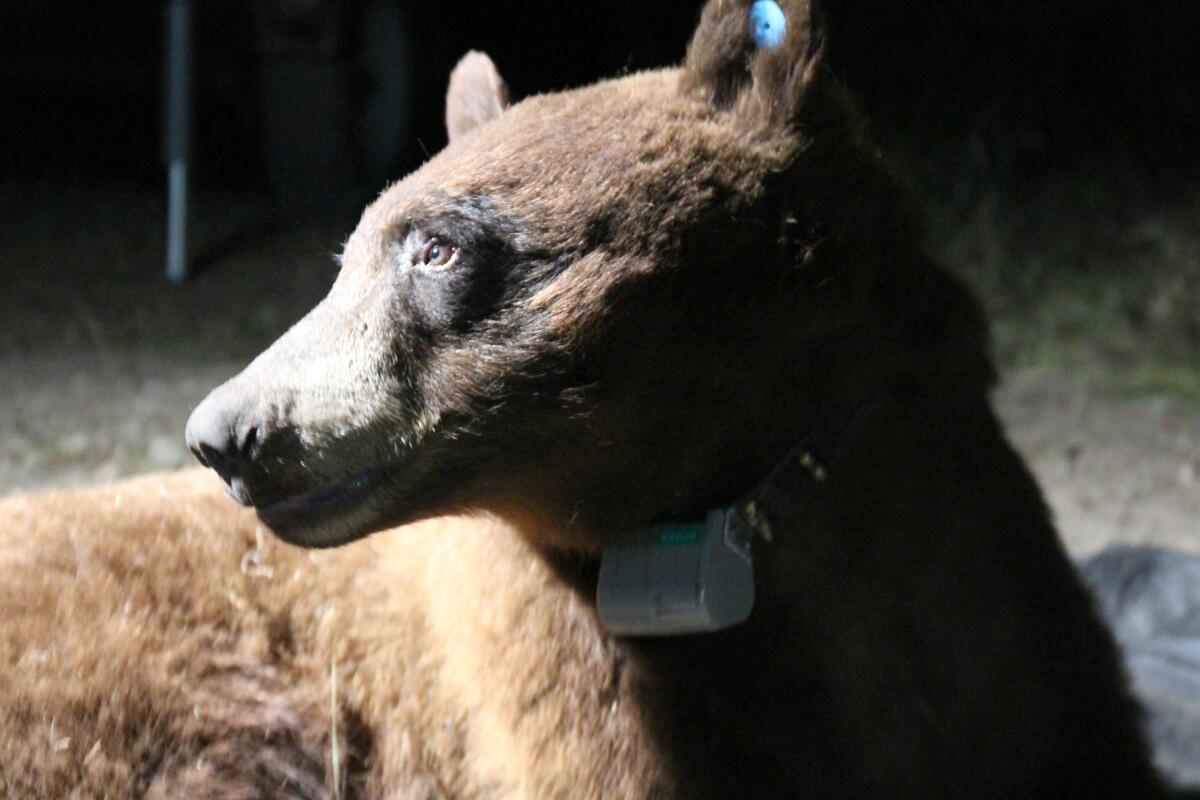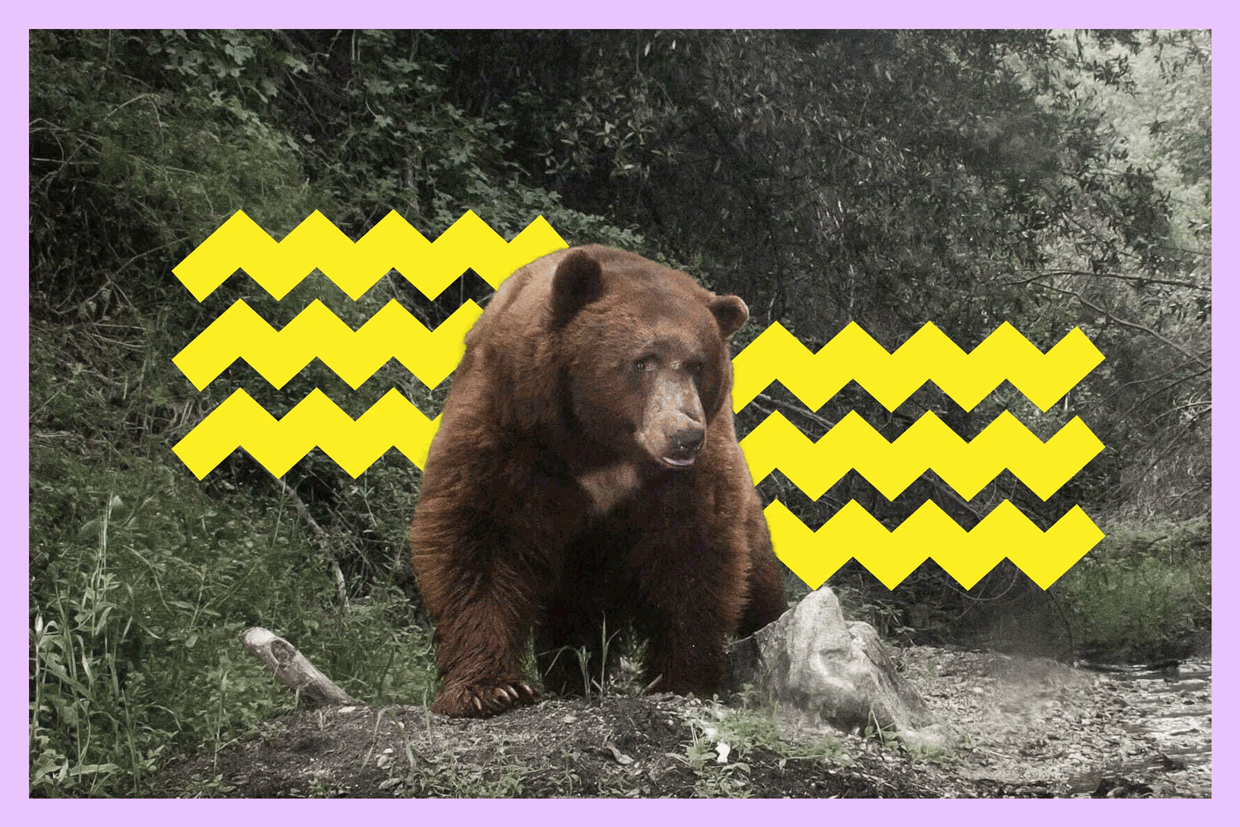Rare bear sighting in San Fernando Valley appears to be the same ‘nomadic’ female

- Share via
A very well-traveled black bear appears to still be traversing the Santa Monica Mountains, leading to another rare spotting of the female bear in the San Fernando Valley last week.
The bear, who wildlife officials believe is Yellow 2291, was captured on security cameras last week, showing the bear walking down a street near Encino, passing a landscaped yard and street signs, according to an image shared by wildlife officials.
The image was taken not long after someone else had reported spotting a bear near San Vicente Mountain Park off Mulholland Drive, according to a post from the Mountains Recreation and Conservation Authority, which manages more than 75,000 acres of public parks across Southern California, including the Santa Monica Mountains.
Enough people fear bears that there’s a name for it: arkoudaphobia. To ease your worries while out hiking, arm yourself with information.
While such a spotting isn’t unheard of for San Fernando Valley communities, it’s quite unusual for the black bears to venture into the Santa Monica Mountains. There is no established population in that range, though in the Santa Susana Mountains and San Gabriel Mountains just to the north and east, there are known habitats for the species, according to the National Park Service.
The majority of California’s black bears live in Northern California and the Sierra Nevada.
But this female black bear appears to have an affinity for the area, despite recent attempts to relocate her.
In July, Yellow 2291 was spotted in Chatsworth, from which wildlife officials were able to take her — for the second time in recent months — to the Angeles National Forest.
But by the first week of August, she had made her way back to the Santa Monicas, and according to her GPS collar, has stayed there ever since, said Jessica West, an environmental scientist with the California Department of Fish and Wildlife who helps monitor Yellow 2291’s movement. The National Park Service is also tracking the bear, known to its team as BB-14.
Yellow 2291 had initially been trapped and tagged by state wildlife officials in Claremont in May, when she was first taken to the more remote national forest. But she somehow made her way around the busy metropolitan area to the Santa Monica Mountains by the summer — crossing, at least, the 5 Freeway, West said.
“We’ve had two trips from her going in and out of the Santa Monicas,” West said. Based on the bear’s movements, she probably also crossed State Road 118 and the 101 Freeway, in all likelihood using underpasses when maneuvering the major roadways.
While West considered the bear’s ramblings exceptional — even helping officials better understand wildlife movement patterns and where more crossings could be helpful — her travels are also quite dangerous. One of the last bears spotted roaming the area was killed on the 101 Freeway.
Yellow 2291, though, is still on the go, traveling in the last few weeks from around the Malibu area, before more recently making her way over to Topanga, West said.
“She’s definitely still moving,” West said. “She has twice now gone up to the 405 Freeway, but we have not seen any attempt to cross. ... She’s been all over the place.”
The bear in the latest photo from the Encino area looked like Yellow 2291, and appeared to match with her recent GPS locations, according to a statement from the California Department of Fish and Wildlife. She was recorded in the the San Vicente Mountain Park area in late September, the agency said.
Wildlife officials have said it’s uncharacteristic for female bears to wander such distances, but none has labeled her recent behavior as concerning.
“For whatever reason, this bear appears to be more nomadic,” West said. Wildlife teams relocated Yellow 2291 in the past because she ventured pretty far from the woods — so they helped her get back. But if she keeps wandering around the Santa Monica Mountains and foothills, they will likely let her be.
“We wouldn’t step in unless there was a public safety concern,” West said. “And from all the reports that we have seen, we haven’t heard of any aggression from this bear. ... She tends to move away from people — like most black bears, honestly.”
Dangerous bear encounters are rare, but if you spot one in your neighborhood or on a hike, experts recommend you remain calm, keep your distance and, most important, don’t run. Most black bears are mainly interested in finding food, West said, which is how they typically end up in suburban or urban areas. She reminded people living in and around the Santa Monica Mountains to be extra careful with trash — or even with bird seed.
“Most of the time, it’s just going to be a sighting,” West said. “It’s about giving them space, don’t approach — and obviously, don’t feed.”
She said it’s also always helpful to report such sightings to wildlife officials.
Times staff writers Jaclyn Cosgrove and Sandra McDonald contributed to this report.
More to Read
Sign up for Essential California
The most important California stories and recommendations in your inbox every morning.
You may occasionally receive promotional content from the Los Angeles Times.












